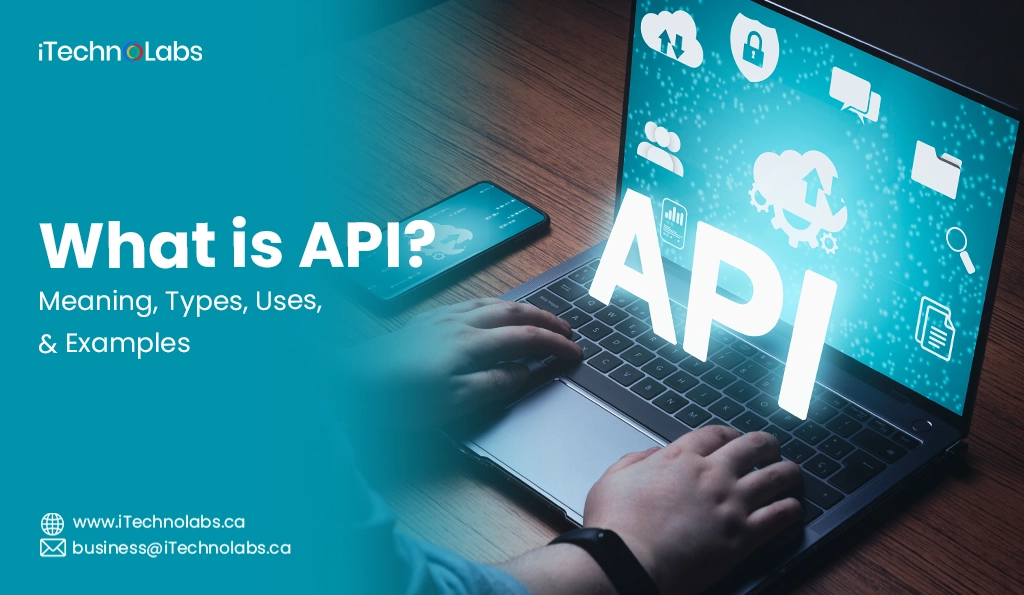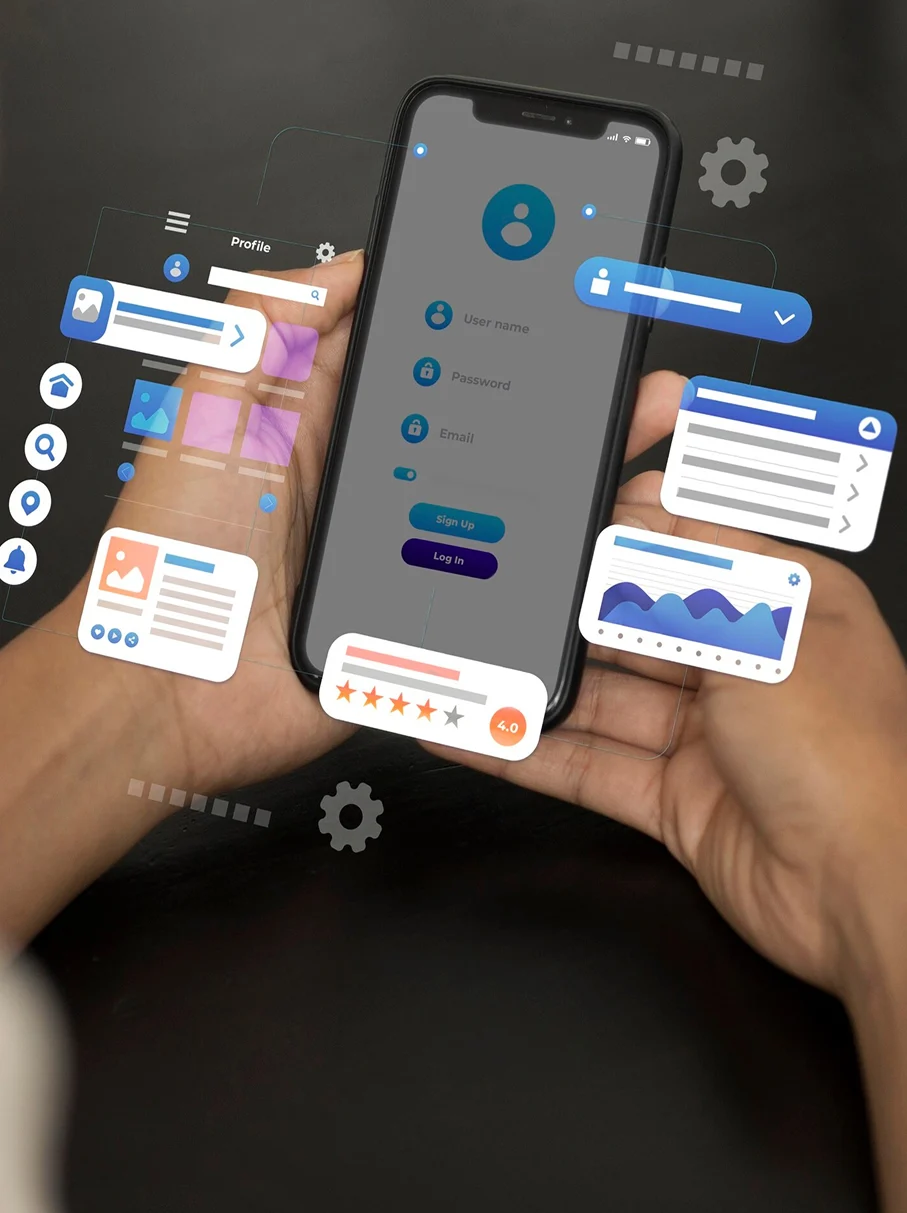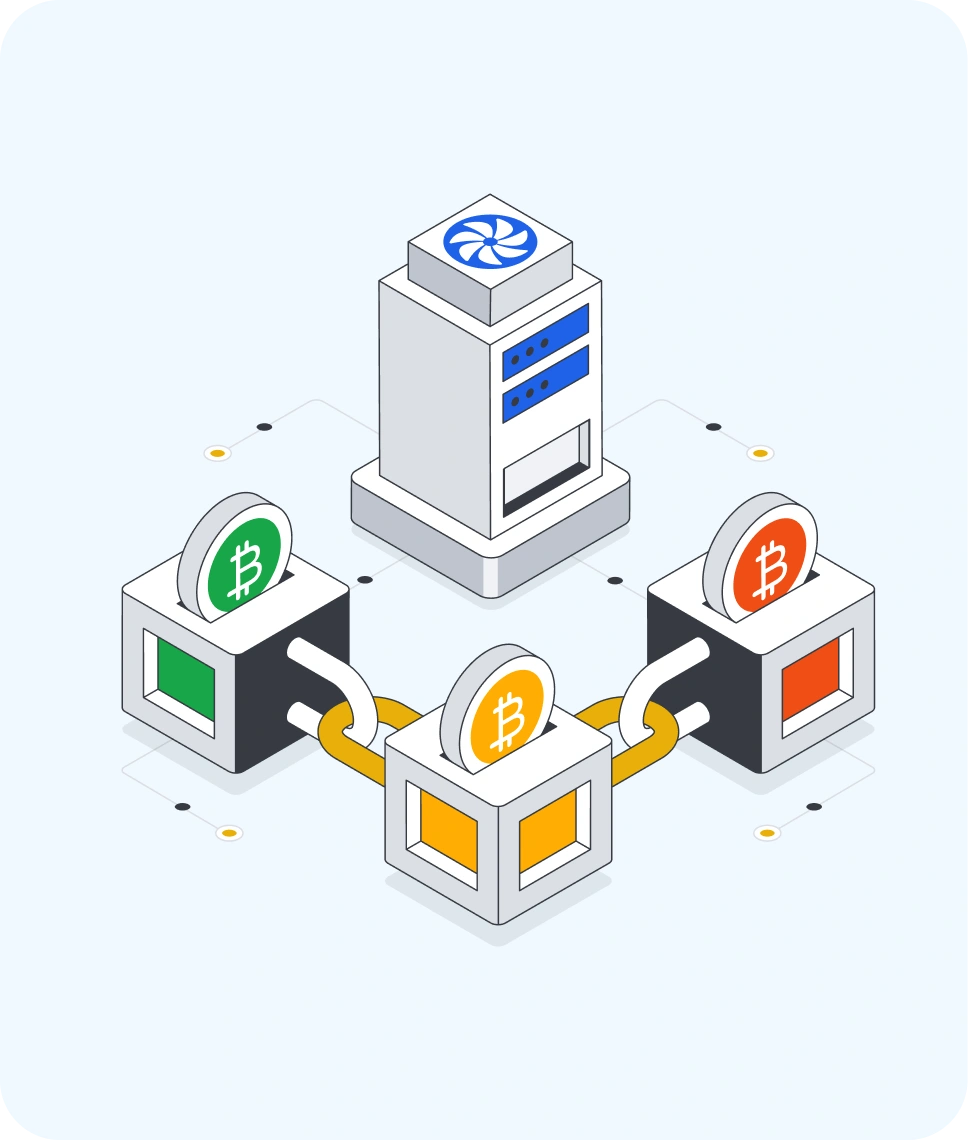An Application Programming Interface (API) is a collection of protocols, routines, and tools used for building software applications. APIs provide the rules and structure for how communications between applications are to take place. APIs are also important when allowing distinct systems to communicate with each other. They enable a developer to add new features to applications by using existing code and will write almost nothing from scratch. This saves the developer time, reduces potential problems, and improves development efficiency.
APIs are used in most software development today to interact and communicate between separate and varied systems and services. APIs are useful for utilizing existing platforms, tools, and services to get a project up and running faster while still maintaining originality and creativity. This guide will take a deep dive into what an API is by exploring various definitions, types, standards, and best practices. We will also review diverse use cases of API usage in the real world and understand the importance of APIs for developing and using applications in every industry.
What is an API? Application Programming Interface
An API is a collection of protocols, routines, and tools for the application-building interaction. It defines how applications communicate over methods and data formats. Finally, APIs serve a function in the middle layer between two or more systems, providing for information exchange in a standard and seamless manner.
APIs are designed to expose basic functionalities of an application or service so developers can pull in only the features they need into their own applications rather than building them from scratch. For example, social media platforms such as Facebook and Twitter provide APIs to allow third-party developers to use their login system or share button within their sites.
Examples of APIs and How They Work
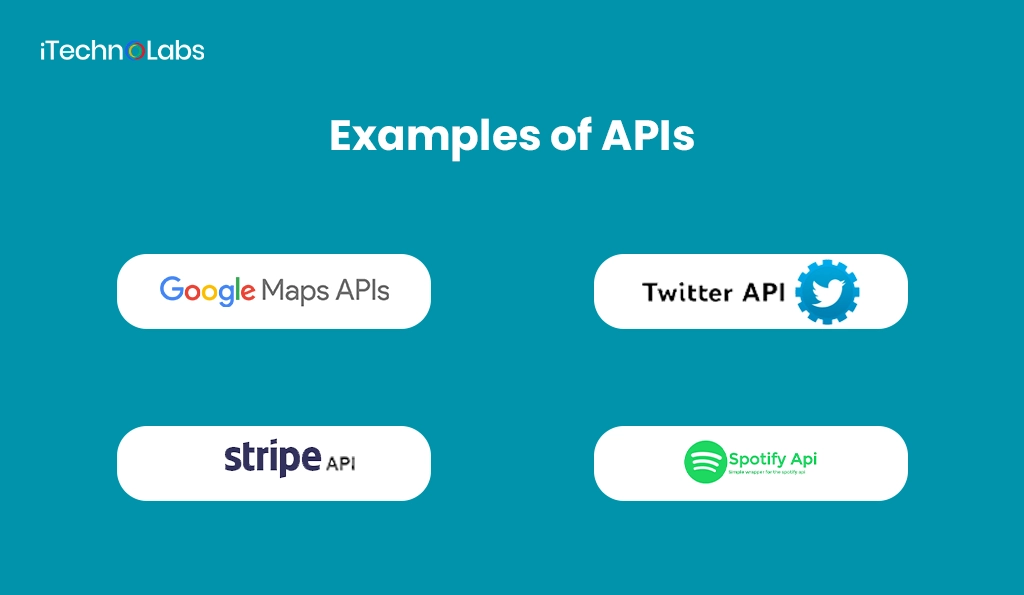
Google Maps API: This API helps get different kinds of geographic data as well as mapping functions. Developers will, in fact, integrate this kind of API into their applications and start using various functions like interactive maps, geolocation, and routing services. That means they can simply use Google Maps in their application or web page, and users can function in real-time navigation and tracking of location, which is actually powered by the vast geographic database available from Google.
Twitter API: Enables developers to use Twitter’s social functions, such as empowering posting, follower management, and user timeline retrieval, in applications that are best with social media by putting Twitter inside them-from dashboards of social media to analytics and even the applications that drive more engagement.
Stripe API: The Stripe API facilitates online payments; the API itself allows developers to integrate payment processing into their applications directly. Thus, it is much more than just an API that accepts a variety of payment methods; it is key to managing transactions and subscriptions and securing information for customers-an obvious one for most e-commerce platforms and financial applications.
Spotify API: Spotify API enables applications to implement music playback and control Spotify Connect devices, as well as gain access to music metadata. This API enables developers to build innovative, memorable music experiences using Spotify’s music library, such as creating playlists and tailoring music suggestions to consumers’ tastes.
Why use an API?
Through the use of APIs in your development project, you can create time and cost savings, efficiencies, and enhanced user experiences. Instead of building data and functions from scratch, developers can skip to the existing data and functions when using APIs. Therefore, APIs save developers time and costs associated with undertaking a development effort.
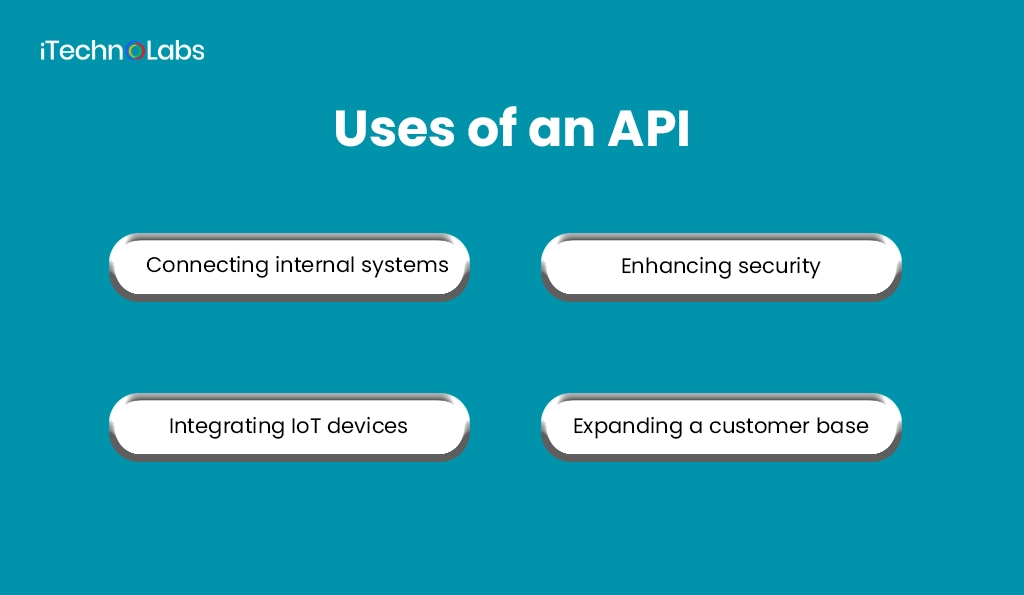
Connecting internal systems:
APIs can also be used to connect internal systems for seamless process improvement within an organization. When APIs are used, departments or teams can hook directly into each other’s processes and data. As a result, silos can be broken down, and various departments/teams can create a more unified organization. When users can see data from different teams and make use of it, the data transfer its greater value to users, and the organization will have more opportunities to function at higher degrees of efficiency, and more opportunities to work together. In other words, teamwork will be better, the organization will make better/faster decisions, and undoubtedly the organization will be very successful.
Enhancing security:
APIs may also increase security controls during development. By integrating a well-proven and reputable API, developers are assured of developing their apps with effective security features. It avoids having to design security functions from scratch, reducing time and cost yet providing the guarantee that sensitive information will be kept secure.
Integrating IoT devices:
APIs have established the interactivity between IoT data and applications/systems with the growth of Internet of Things (IoT) devices. Developers are able to leverage APIs and bring IoT data into applications for real-time intelligence and experiences. For illustration, if you have a healthcare app, wearable devices can provide data and be sent in real-time to healthcare professionals.
Expanding a customer base:
Third-party developers create applications to expand the company’s client base integrated with APIs, which add value for businesses in terms of exposure to brands and new revenue streams generated from clients. Example: APIs offered by social networking sites such as Facebook and Twitter to facilitate third-party developer app creation toward interaction with social media’s user base attached to the application.
How do APIs work?
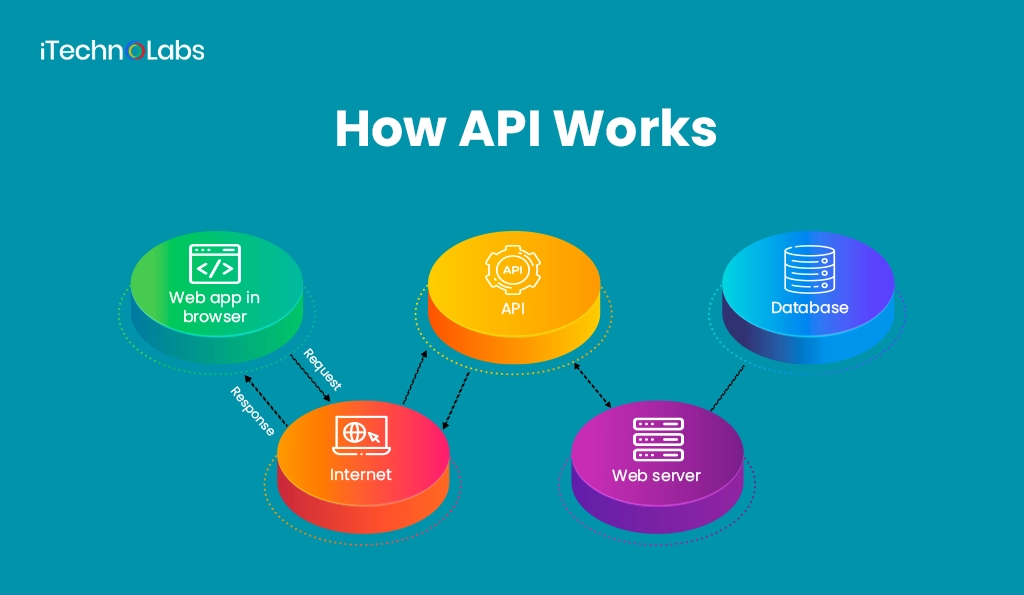
To generally describe how an API operates, most people use the request-response model of communication between a server and a client. In this case the client is any front-end application the user sees, while the server performs back-end application logic and database operations. Inserted between the server and client is an API, which is an intermediary layer that enables data request and response exchange. Red Hat experts point out that APIs can be viewed as contracts and their documentation as a kind of agreement: “When party 1 makes a remote request in a certain format, this is how party 2’s software will react.”
This idea of a contract is codified in so-called API specifications or protocols—a detailed structure that defines the behavior of the interface to be expected and provides a starting point for building a given API. Inside this structure, the protocol clarifies the primary elements of the API, even though we shall explore the most common API specifications further along in our presentation.
API components: calls, keys, endpoints
APIs consist of a number of important elements that constitute the core of their functioning and enable interaction between software programs.
- API Calls: An API call or request is a request sent to a server by a client wishing that the server do something or retrieve some data. The request is then processed, and the server sends back a response to the client, thus closing the loop of communication. Calls normally implement some methods like GET, POST, PUT, and DELETE on the resources.
- API Keys: API keys are special codes provided by the server to verify the client requesting the access. These are used to ensure security and access control so that only the authorized ones can make API calls. API keys typically have to be sent along with requests and serve as an identifier and key to open the door for using the features of the API.
- Endpoints: Endpoints are precise URLs in an API that identify unique functions or data sets. Each endpoint maps to a specific resource or operation that a client can interact with. A good API will have properly defined endpoints where developers can easily understand and utilize the API in order to realize desired functionalities within their applications.
API vs webhooks
| Aspect | API | Webhook |
| Data Flow Control | Client has control over when to request data | Server determines when data is pushed based on events |
| Security Considerations | Requires careful handling of authentication tokens | Needs secure endpoints to prevent unauthorized data pushes |
| Integration | More flexible, suitable for complex operations and multiple data interactions | Easier to integrate for specific, event-driven actions |
| Resource Consumption | Can consume more resources due to polling | More resource-efficient as it reacts only to events |
| Use in Development | Better for client-driven applications with high privacy needs | Suited for applications requiring real-time updates with minimal delay |
| Failure Handling | Retries can be managed through request-responses | Requires additional error-catching mechanisms, such as retry mechanisms after failure |
| Suitability for Mobile | Can be more taxing on battery and data usage | Optimized for devices as it mitigates unnecessary data transmission |
Whereas APIs allow users to pull data from a server by making particular requests, webhooks work in reverse. A webhook is an automated push message that occurs when a predetermined event happens on a server or within an application. This event-driven process allows the server to send a request to a client-oriented URL with a notification-type message as an event occurs without an actual request from the client. API calls are the converse, meaning the client submits a request and polls the server as often as needed for an update or response. This polling does not send information from the server until it is requested. Webhooks are a good alternative and better implementation because they remove a portion of the polling process by sending real-time updates as they occur.
Webhooks provide a particularly useful service in situations where there is a need to take an action based on an event, such as notifications, real-time workflows, or database refreshes. For example, an e-commerce site could use webhooks to notify an inventory system that a product has sold and to adjust stock levels immediately.
APIs are better for bulk data retrieval and more complex processes that have multiple calls and responses. They are optimal when a client is required to gather information from a server at a particular instant or conduct activities that involve thorough, structured interactions.
APIs and webhooks are both core technologies for enabling smooth app-to-app communications but for different ends. The API supports data readout and involved actions through formal requests, while webhooks trigger instant notifications and live updates right from the server. Both tools can be blended with one another to create capable, efficient, and interactive systems to improve general functionality and experience.
API vs SDK
API stands for Application Programming Interface and SDK stands for Software Developer Interface. Developers need both APIs and SDKs to access and interact with an external system or service. APIs allow developers to use a standard interface, otherwise locking the capabilities and data of existing systems and services to assist with integration.
The APIs are a defined set of protocols, definitions, and tools that communicate to two applications, giving two software systems the capacity to exchange information and perform actions. APIs can be this ‘integration layer’ for a software system to build on another software without having to expose all your underlying code again. APIs can be public or private.
SDKs, on the other hand, are collections of these tools provided by the platform or service that might have libraries, support, documentation, etc. An SDK typically comes along with code samples, debugging tools, etc., that assist developers with how best to integrate their application with the platform or service.
Examples of APIs
- Twitter API: Provides an interface to work with most aspects of Twitter, such as posting tweets, following users, and accessing user timelines.
- Google Maps API: Allows applications to connect and interact with Google Maps for application functions like displaying a map, searching for a location, and giving driving directions.
- Facebook Graph API: Provides a plug to Facebook’s social graph, which enables applications to read and write data to Facebook.
- YouTube Data API: Allows developers to manipulate YouTube content and features such as uploading videos, managing playlists, and retrieving video metadata.
- Dropbox API: Offers possibilities for integrating with Dropbox for the management of files, folders, and user accounts in the Dropbox environment.
Examples of SDK
- iOS SDK: That SDK based on iOS incorporates tools and resources that help to develop applications for Apple devices running the iOS operating system, formulate user interfaces, and access device hardware features.
- Android SDK: This offers a set of development tools for the Android platform, like building user interfaces, connecting to services, and handling device capabilities.
- AWS SDK: Through APIs, the AWS SDK allows developers to add cloud computing capabilities of Amazon Web Services (AWS) to the applications.
- Microsoft Azure SDK: Provides the tools and resources needed to develop applications capable of interacting with Microsoft Azure cloud services by means of APIs.
- Salesforce Mobile SDK: The Salesforce Mobile SDK would allow developers to build mobile apps integrated with Salesforce’s CRM business process and data, allowing access and management of customer and sales data along with business process capabilities.
- Twilio SDK: Connects to Twilio’s platform of communication so that developers can build voice, SMS, and video messaging capabilities into their apps.
API Types
There are a variety of types of APIs, each for a distinct purpose and needing a specific range of interactions. Some popular types of APIs include
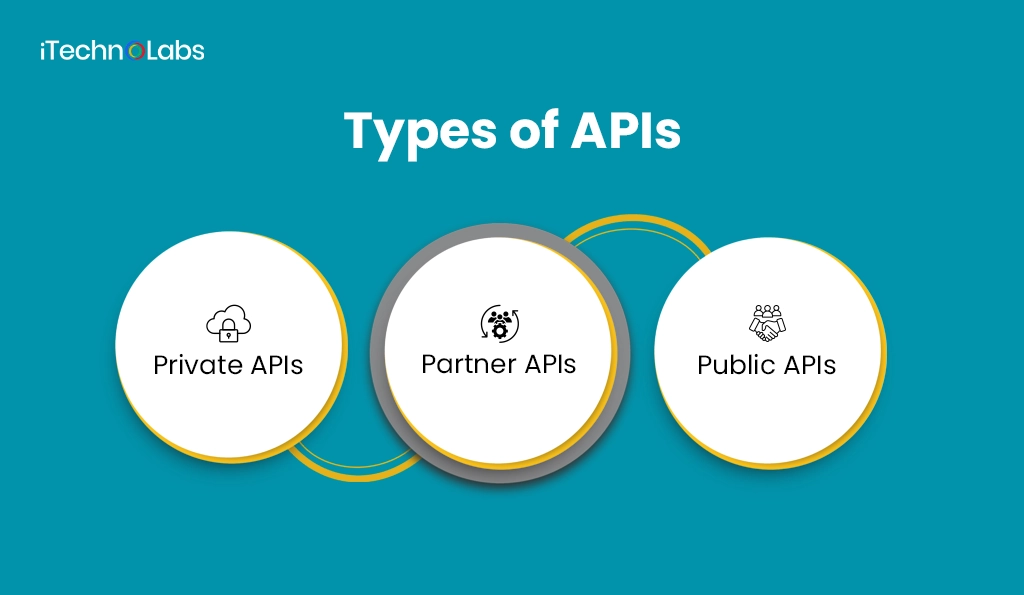
In terms of release policy, APIs may be private, partner, or public.
Private APIs: Private APIs are only accessible within an organization or a company and not to the general public. Private APIs are mostly utilized for communication between internal systems and services of an organization.
- Google’s Internal APIs: Utilized by Google employees for integrating internal tools such as billing systems or employee portals.
- Amazon Inventory Management API: Internally utilized by Amazon to manage and maintain inventory systems for their worldwide warehouses.
- Netflix’s Internal APIs: Allow its various microservices to communicate for user management, content recommendation, and playback.
Partner APIs: Partner APIs are only available to the limited set of people that the API provider calls “partners.” The use of Partner APIs has been generally prevalent in business-to-business (B2B) integrations where two businesses are partners that are exchanging data and functionality for both businesses’ services. Vendor and other forms of support agreements provide intended partners with restricted access to a Partner API and allow the API provider to ensure that the APIs are operating in a secure environment, resulting in more secure and quicker integrations. Restricting access to a Partner API may also facilitate deeper business relationships with opportunities for more closely cooperating companies, leading toward shared growth and innovation.
- Salesforce API for Partner Integration: Allows partners to build applications that extend Salesforce functionalities, like CRM integrations.
- PayPal Partner API: Used by businesses like eBay to offer payment services within their platforms.
- Uber API for Business Partnerships: Shared with companies like airlines or hotel booking platforms for ride integrations directly into their apps.
Public APIs: These APIs are available to the general public and can be accessed by anyone with proper authentication.
- Google Maps API: Used by developers to integrate mapping and geolocation services into apps and websites.
- Twitter API: Enables developers to interact with Twitter data, such as posting tweets or fetching trending topics.
- OpenWeatherMap API: Provides weather data for applications like mobile weather apps or travel websites.
There are two types of public APIs—open (free of charge) and commercial ones.
Open APIs are free to use and often do not limit the amount of requests or data consumption. Open APIs are typically provided by organizations or individuals who want to share their data and functionality with the wider world. They commonly provide an API to assist community or non-profit efforts, primarily to raise visibility and attract developers to create new applications based on their API. For an open API, meant to be free to use, they allow developers to experiment and learn and build new applications or services, all without restrictions on costs or limitations. The openness of these APIs means the organization’s project can spur collaboration and enable the development of all kinds of creative projects shared throughout various sectors, whether that is a project shared with the school or educational sector or in the context of community actions, research, and more.
Commercial APIs involve a fee and typically have many fees ranging in price based primarily on the access amount, amount of support, and the features that come with the unlimited access tier. Organizations will often leverage these commercial APIs as companies want to make money through the sharing of their data and services through API integration. Usually, price levels are designed to support varying needs of users, from minimum-level access for solo developers up to corporate plans for enterprise applications. This way, companies can select an option tailored to their financial and technical needs. Moreover, most commercial APIs provide good documentation and specialized customer support to help users integrate the API with no hassles into their applications.
Also Read: Zillow API Cost
APIs by Use Cases
APIs can be classified according to the systems for which they are designed.
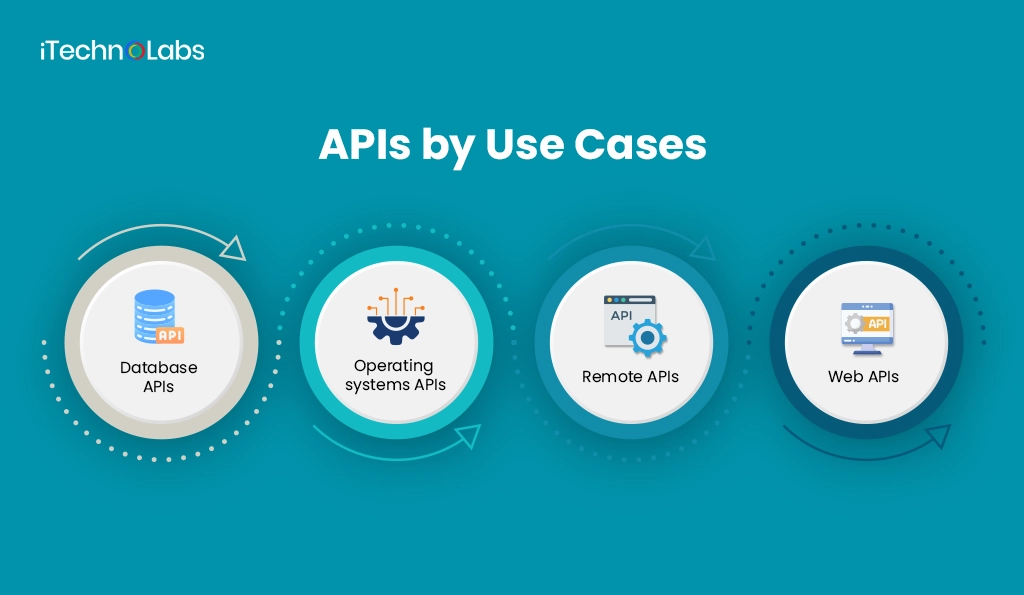
Database APIs: These APIs are very useful in accessing and manipulating data that could reside in many different forms of data sources, such as an SQL or NoSQL database. They provide an established way to access and manage database resources, therefore taking away some of the overhead for developers because they are able to access databases without having to understand the database programming language or protocol. This is very helpful where an application makes extensive use of data and requires reasonably quick access to that data, because it means that there is a good abstraction that allowed them to integrate a database and its functionality and use it across multiple data sources in their application. It is important that the developer engage with any complex querying of data, direct manipulation of data, or simple update, as they now have absolute conviction when engaging with new data sources, and they do not have to guess if this access to this source is going to work; they are confident in their approach and go about their day.
Operating system APIs: The operating system APIs are useful in accessing resources and functionalities provided by operating systems like Windows or Linux. They serve as the intermediary set of routines, protocols, and tools that allow the application to communicate easily with the processes and services at the system level. This comprises file management, whereby programs read, write, and structure files; networking, whereby data is transferred through networks; and memory management, which aims at the better allocation and utilization of memory within systems. This cooperation between the software programs and the operating system is what gives optimal performance in effectiveness and efficiency to the software and is, therefore, essential in programming without APIs.
Remote APIs: As the world continues to become more interconnected, remote APIs are becoming more important. Remote APIs allow one to connect with other devices, services, or systems over the Internet or other networks using other devices to exchange data and functionality. For instance, the functionalities of a weather API are that it collects and aggregates data from many varied sources and enables developers to use that data through an interface. Unlike an API directly connected to the device, a remote API is very useful when you need to provide real-time information or if you need to interact with third-party services like social media or payment gateways.
Web APIs: Web APIs are remote API utilities that are specifically created with the thought of interactivity when using web-based applications. They provide constant interactions between web servers and their client-side applications, accessing resources, for example, databases, files, or simple services. Thus, web APIs are crucial for creating dynamic and interactive websites/web-based applications that have potentially a real-time component and/or the possibility of user personalization. Web APIs have become increasingly popular with both cloud and web-based service integration as they provide upgraded capabilities and new possibilities for creativity.
Example web APIs are the Google Maps API, which provides mapping functionalities for application developers to integrate geographic features into their applications; the Twitter API, which gives access for fetching tweets and social media analytics; and the Facebook Graph API, which responds with interaction with the social graph of Facebook. These APIs are backbone tools for a developer who wants to take advantage of the features that the internet presents in the developer’s applications.
API Formats and Specifications
APIs utilize many of the same formats and protocols to promote the interoperability of various systems. The two common specifications include REST (Representational State Transfer) and SOAP (Simple Object Access Protocol). Both have advantages and disadvantages, and both are designed to solve different problems.
Remote Procedure Call (RPC) APIs
RPC APIs (Remote Procedure Call APIs) are an older format of web services that have been largely replaced by REST and SOAP processes. RPC APIs allow for a remote procedure call from a single application to a remote server or a procedure call from the remote server back to the application. They allow access to remote data and remote services as if they were local resources, in that a developer can call functions or procedures on a different machine without caring what the network looks like in between. There are limitations with RPC APIs, and one of those limitations is scaling since they have to manage and stream a large amount of data very efficiently. The second limitation is due to the conceptual side of RPC APIs; they are so tightly coupled that if a change is made to a procedure on one end, the other must change to accommodate, thus complicating maintenance and changes needing to be made as your system scales. That said, since RPC APIs require so little thought to help publish and implement, they can be used and work perfectly in scenarios where ease of use and less thought are conceptualized.
Service Object Access Protocol (SOAP) APIs
SOAP APIs or Service Object Access Protocol APIs: SOAP APIs are a more complicated and heavier method of web services than REST. SOAP APIs utilize XML as a messaging protocol and support many transport protocols such as HTTP, SMTP, and FTP. SOAP is beneficial because it can satisfy security standards such as WS-Security, transactions, and many other features conducive to developing enterprise applications with reliable, secure operations. The flexibility and robust features of SOAP usually come with the additional cost (in time and resource allocation) of complexity, making them harder to deploy and maintain.
Representational State Transfer (REST) APIs
Presently, REST APIs (Representational State Transfer Application Programming Interfaces) are the most popular and commonly utilized format for web services. They change the whole dynamic of how data is passed back and forth over the internet and REST APIs accomplish this with simple, lightweight HTTP requests to swap your data, hopefully in one of the several formats (JSON, XML, etc.) that can easily be understood by man and machine. REST APIs are based on scalability as a design principle so that a system can manage more and more work without sacrificing performance. In other words, REST allows for loose coupling between clients and servers that helps allow developers to change a particular part of the application without impacting other parts based on one common concept. This improves maintainability and flexibility for developers to create future situations.
Yet another reason that many developers want to implement REST APIs is because of how highly modular they are and how well they integrate with other systems. In other words, REST APIs are stateless, which means that each request that a client makes contains all the information needed to process that request, therefore allowing REST APIs to be speedy and to have a lighter load on the server, which are both really important characteristics, especially for mobile applications and most IoT devices, because in both mobile applications and IoT devices, speed and lightweight data transactions are critical factors in providing a good user experience for actual end-users. The consistency across implementations and services has been extremely useful in bridging communications between services across various industries.
gRPC
gRPC, or Google Remote Procedure Call, is a modern, open-source, remote procedure call framework designed and developed by Google. It serves as an alternative to traditional REST APIs and provides significant improvements to the traditional methods. gRPC uses the HTTP/2 protocol to communicate with remote web servers, whereby both application latency and performance are improved. It has a very wide array of supported programming languages and performing platforms.
One of the major advantages that gRPC has since it was introduced is that it does not use conventional data interchange formats such as JSON or XML, but rather uses Protocol Buffers. Protocol Buffers, as the name defines, are binary encoding and are, therefore, faster in serializing their data. Thus, this leads to a streamlined transfer of data from one server to another.
GraphQL
GraphQL is a contemporary replacement for REST APIs that was invented way back in 2015 by Facebook. The GraphQL API provides a query language for the API, where clients can request to get exactly the data they want and nothing more from the server. This avoids the different traditional REST API problems of over-fetching or under-fetching. It allows multiple resources to be fetched in a single request, reducing network round trips and also increasing performance.
Introspection of the schema is perhaps one of the most significant benefits that GraphQL provides; this means that a developer can know what an API can do and what data types it can return without the need for another document outside the system, thus speeding up the process of development.
Also Read: 3d Game Development Cost
Common Examples of API
Examples of how to utilize the API are an important source in general documentation to allow one to understand how to use and integrate the API into one’s project. The API example(s) should demonstrate different use case scenarios so users can understand how perhaps to utilize the API differently in different scenarios.
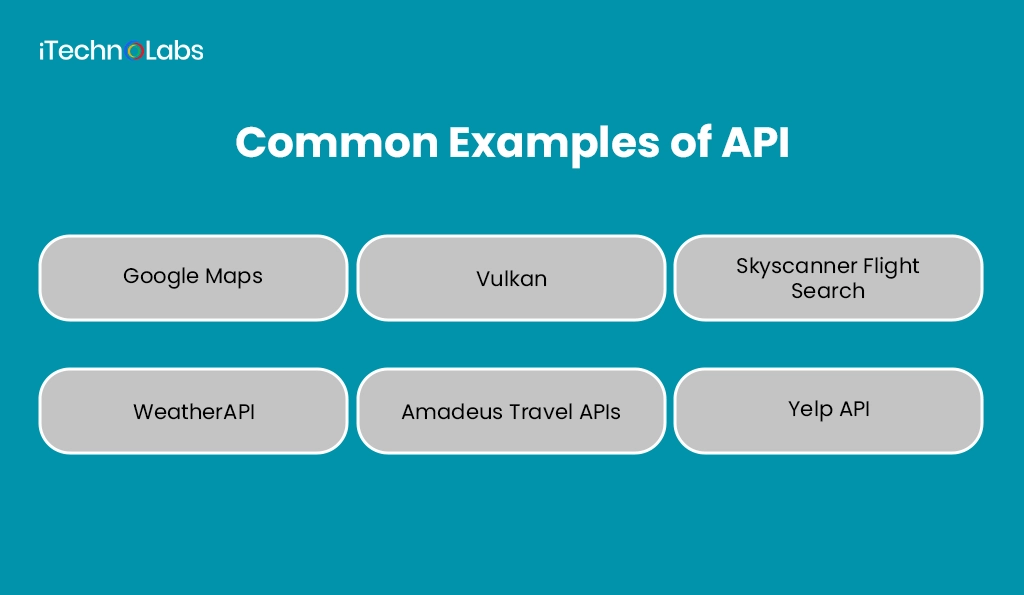
Some common types of API examples include
Google Maps: Google Maps has a number of examples of APIs that can be incorporated into different applications and serves as a resource for developers looking for variations to the use/display of this API. It has a number of examples and good explanations about how to show maps in a different style, how to use layers, how to display markers that represent different locations with other icons and different colors, and how to incorporate Google Places, which provides detail on various places, and Google Directions to enable users to find locations and plan routes. By utilizing these APIs, developers can create applications that are more interactive with the users and employ mapping or guides, which could greatly enhance end-user experience.
Vulkan: Vulkan, a graphics and compute API, provides many examples that can be very useful for developers looking to use its powerful capabilities. The examples are well-designed and go over many different subjects, including windowing systems to manage how communication with the graphics processor diverges to show images on various devices. You’ll also see multithreading examples, which are important to modern applications. Anyone working with Vulkan will need to understand threads to optimize performance by processing tasks simultaneously.
Skyscanner Flight Search: Skyscanner’s Flight Search API contains a variety of examples that demonstrate searching for flights and getting detailed information about the flights and even booking the flights. The examples clearly demonstrate how developers can utilize the rich features of the API, including how to authenticate and handle different ways to authenticate access to flight data. The examples show how to handle errors, enabling a smooth user experience. Following the examples, the developer will be able to integrate into their applications and utilize Skyscanner flight search capabilities, providing useful and up-to-date travel information and ticket booking capabilities to their applications.
WeatherAPI: WeatherAPI offers a full range of examples of how to obtain different types of weather data, including current weather conditions, forecasts, and historical weather data. These examples serve to exemplify the power of the API in different programming languages and libraries, including Python, JavaScript, and Java, allowing developers to easily enrich their projects with relevant weather data. WeatherAPI provides simple snippets of code that are easy to understand so that developers are able to better comprehend the functionality of the API and assist them with building timely and accurate weather data into their projects.
Amadeus Travel APIs: Amadeus, a prominent travel technology company known for its innovative solutions, offers a comprehensive suite of APIs designed for developers to seamlessly integrate into their projects. These APIs cover a wide range of functionalities, catering to diverse needs in the travel industry, such as flight search, hotel booking, and car rental services. The robust API documentation provides detailed examples of how to effectively make requests and adeptly handle responses. Additionally, it guides developers on how to implement advanced features to enhance user experiences. By utilizing these APIs, developers can create tailored travel solutions that meet the evolving demands of the industry.
Yelp API: The Yelp API allows developers to access a vast repository of business data, reviews, and user-generated content. With over 200 million business listings in its database, the Yelp API covers a wide range of industries and locations globally. Developers can leverage this extensive collection of data to build innovative solutions that cater to consumers’ specific needs. Furthermore, the Yelp API offers robust search capabilities, allowing developers to filter results based on various criteria such as location, category, price range, and more. By utilizing this powerful API, developers can create unique experiences for their users while providing them with valuable insights into businesses around the world.
Conclusion:
In today’s rapidly evolving digital landscape, the role of APIs is more critical than ever in ensuring seamless connectivity and fostering innovation. APIs act as the glue that binds various software components, enabling them to communicate effectively and perform complex tasks. Embracing the latest technological advancements, such as microservices architecture and cloud computing, alongside prioritizing comprehensive testing and robust security measures, can significantly elevate the reliability and scalability of API solutions.
By focusing on robust integration and providing ongoing support, organizations can minimize operational disruptions, optimize performance, and foster a future-ready technological ecosystem capable of adapting to changing demands. Ultimately, prioritizing these elements not only enhances user confidence by delivering consistent and secure experiences but also sets a solid foundation for long-term success in an increasingly competitive market.
FAQs
- What is an API with an example?
An API (Application Programming Interface) allows different software systems to communicate with each other. It defines rules for how requests and responses should be structured. For example, a weather app uses a weather API to fetch live data from a weather server and display forecasts in your app.
- What are the four types of APIs?
The four main types of APIs are
- Open APIs – publicly available for developers.
- Partner APIs – shared with specific partners.
- Internal APIs – used within an organization.
- Composite APIs – combine multiple APIs into one call, often used to improve performance or simplify complex operations.
- What is API in a nutshell?
In a nutshell, an API is a messenger that lets software applications talk to each other. It defines how requests should be made, what data is needed, and how responses are delivered. APIs enable developers to use functions or data without understanding the code behind them.
- What is an API for dummies?
Think of an API as a restaurant menu. You (the user) choose what you want, the waiter (API) takes your request to the kitchen (server) and brings back your food (data). You don’t need to know how to cook—it just works. APIs help apps get and send information easily.
- Is API a programming language?
No, an API is not a programming language. It’s a set of rules and tools that allows different software programs to communicate. APIs are used within programming languages like Python, Java, or JavaScript to connect apps, access web services, or control software components.

